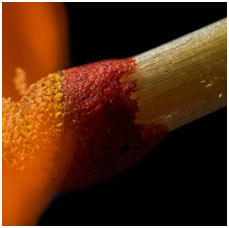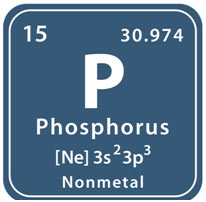Introduction
Phosphorus is a member of group 15 located just below nitrogen.
- Phosphorus has 15 electrons.
- Its atomic number is 15 whereas its atomic weight is 30.
- It has 5 electrons in its valance shell so is a multivalent element.
Naming and History
Phosphorus got its name from the Greek word “phosphoros” which means light-bearing. It is because on oxidation with air, phosphorus produces a green glow in dark.
In 1669, a German physician and chemist named Hennig Brand first isolated phosphorus. He heated urine until it evaporated and then further heated the remaining residue until it became hot red.
The vapour came off, then, Hennig condensed t underwater. He thought he had produced Philosopher’s stone, so he kept his procedure secret. He sold phosphorus to Daniel Kraft who displayed it in Europe where Robert Boyle was fascinated by it.
Robert Boyle studied it systematically and discover the method of its production. Carl Wilhelm Scheele replaced the extraction method of Hennig Brand by extracting it from bones.
Occurrence of Phosphorus
It is the seventh common element on Earth. Due to high reactivity phosphorus does not exist in its pure elemental form. It commonly occurs in the rocks (Ca3(PO4)2) and minerals called phosphates.
Properties of Phosphorus
Phosphorus is a nonmetal and highly reactive element with multiple valances. It is colorless in its pure form but ordinary phosphorus is a white waxy solid. It has a density of 1.82 grams per cubic centimeter. The melting point of phosphorus is 44.15°C and the boiling point is 280.5°C.
Phosphorus in Biological Systems
Phosphorus is a very important element for all life forms. It is the component of ATP – the energy currency of living things. It makes the sugar-phosphate backbone of nucleic acids i.e., DNA and RNA.
Phosphorus is also part of other biomolecules. It is essential for plants for their proper growth and development. Excess phosphorus can pollute rivers and cause algal blooms which lead to eutrophication.
In humans, phosphorus is required for the proper functioning of the nervous and skeletal systems. The deficiency of phosphorus is called hypophosphatemia. Too much phosphate also causes serious problems. It can damage the kidneys and liver. White phosphorus can cause severe burns.
Allotropes of Phosphorus
There are three common allotropic forms of phosphorus.
White Phosphorus
White phosphorus is the common one that is also manufactured in industries on a commercial level. On oxidation with air, it produces a glow in the dark. It is flammable when comes in contact with air and is highly toxic. White phosphorus consists of a P4 tetrahedral molecule.
Due to its high reactiveness, it is stored underwater and is used for preparing other phosphorus compounds.
Red phosphorus
Due to variations in chemical structure, it ranges from orange to purple color. Red phosphorus can be formed by heating white phosphorus or exposing it to sunlight. On further heating, it can be crystallized.
It is not dangerous and poisonous like white phosphorus. It is used in making fireworks, smoke bombs, and pesticides.
Black Phosphorus
It looks like graphite in appearance and can also conduct electricity. It is formed under high pressure. It is the least reactive form of phosphorus.
Uses of Phosphorus

White phosphorus is utilized in flares and incendiary devices.
Red phosphorus remains in the material stuck on the side of matchboxes, used to strike safety matches against to light them.
The largest use of phosphorus substances is for fertilizers. Ammonium phosphate is made from phosphate ores. The ores are first converted into phosphoric acids prior to being made into ammonium phosphate.
Phosphoric acid (H3PO4) is used in sodas and soft drinks and to create numerous phosphate substances, such as triple superphosphate fertilizer (Ca(H2PO4)2 · H2O).
Trisodium phosphate (Na3PO4) is utilized as a cleaner and as a water softener.
Phosphates are utilized for special glasses, sodium lamps, in military applications (incendiary bombs, smoke screenings, etc.), and in other applications as: pyrotechnics, pesticides, toothpaste, cleaning agents.
Bone ash (calcium phosphate) is utilized to make chinaware and to make monocalcium phosphate for baking powder.
Phosphorus is utilized to make steels and phosphor bronze and is added to other alloys. There are many usages for organic phosphorus substances.
Isotopes of Phosphorus
Phosphorus (15- P) has 23 isotopes from 25- P to 47- P, just 31- P is stable; as such, phosphorus is thought about as a monoisotopic element. The longest-lived radioactive isotopes are 33- P.
Phosphorus-32
It is utilized regularly in life-science laboratories, mainly to produce radiolabeled DNA and RNA probes, e.g., for usage in Northern blots or Southern blots.
Phosphorus-33
It is utilized in life-science labs in applications in which lower energy beta emissions are advantageous such as DNA sequencing. 33- P can be used to label nucleotides.
MCQs about Phosphorous Element
- What is the atomic number of phosphorus?
- A) 14
- B) 15
- C) 16
- D) 17
- Answer: B
- Why is phosphorus named “phosphoros”?
- A) It is derived from the Latin word for fire.
- B) It means light-bearing.
- C) It signifies high reactivity.
- D) It is related to its color.
- Answer: B
- Who first isolated phosphorus and how?
- A) Robert Boyle, through systematic study
- B) Carl Wilhelm Scheele, by extracting it from bones
- C) Hennig Brand, by heating urine and condensing the vapor
- D) Daniel Kraft, by displaying it in Europe
- Answer: C
- In which form does phosphorus commonly occur in rocks?
- A) Pure elemental form
- B) White phosphorus
- C) Phosphates
- D) Red phosphorus
- Answer: C
- What is the density of ordinary phosphorus?
- A) 1.82 grams per cubic centimeter
- B) 2.5 grams per cubic centimeter
- C) 3.0 grams per cubic centimeter
- D) 4.2 grams per cubic centimeter
- Answer: A
- Which biomolecule does phosphorus make the sugar-phosphate backbone for?
- A) Proteins
- B) Carbohydrates
- C) Nucleic acids (DNA and RNA)
- D) Lipids
- Answer: C
- What is the consequence of excess phosphorus in rivers?
- A) Acidification
- B) Eutrophication
- C) Desalination
- D) Sedimentation
- Answer: B
- How is white phosphorus stored due to its high reactivity?
- A) Exposed to sunlight
- B) Underwater
- C) In open air
- D) In a vacuum
- Answer: B
- Which allotrope of phosphorus is used in making fireworks and smoke bombs?
- A) White phosphorus
- B) Red phosphorus
- C) Black phosphorus
- D) Purple phosphorus
- Answer: B
- What is the primary use of white phosphorus in incendiary devices?
- A) Heating
- B) Lighting
- C) Reacting with air
- D) Producing a glow
- Answer: B
- Which substance is commonly used as a cleaner and water softener and contains phosphorus?
- A) Ammonium phosphate
- B) Phosphoric acid
- C) Trisodium phosphate
- D) Triple superphosphate
- Answer: C
- What is the major application of phosphates in the military field?
- A) Fertilizers
- B) Pyrotechnics and incendiary bombs
- C) Toothpaste
- D) Cleaning agents
- Answer: B
- Which radioactive isotope of phosphorus is commonly used to label nucleotides in life-science labs?
- A) Phosphorus-31
- B) Phosphorus-32
- C) Phosphorus-33
- D) Phosphorus-47
- Answer: B
- What is the primary use of Phosphorus-33 in life-science labs?
- A) DNA and RNA sequencing
- B) Radiolabeled DNA and RNA probes
- C) Lower energy beta emissions
- D) Northern blots
- Answer: A
- Which element is located just below phosphorus in the periodic table?
- What is the significance of the green glow produced by phosphorus on oxidation with air?
- A) It indicates toxicity
- B) It signifies its multivalence
- C) It gives phosphorus its name
- D) It is a property of white phosphorus
- Answer: C
- What is the consequence of excess phosphate in humans?
- A) Damage to kidneys and liver
- B) Enhanced brain function
- C) Improved bone density
- D) Increased energy levels
- Answer: A
- Which allotrope of phosphorus is the least reactive?
- A) White phosphorus
- B) Red phosphorus
- C) Black phosphorus
- D) Orange phosphorus
- Answer: C
- What is the primary use of trisodium phosphate?
- A) Fertilizer
- B) Cleaner and water softener
- C) Incendiary bombs
- D) Radiolabeled probes
- Answer: B
- What is the primary component of ATP, the energy currency of living things?
- Which isotopes of phosphorus are stable?
- A) Phosphorus-31
- B) Phosphorus-32
- C) Phosphorus-33
- D) Phosphorus-47
- Answer: A
- What does the deficiency of phosphorus in humans lead to?
- A) Hyperphosphatemia
- B) Hypophosphatemia
- C) Hypercalcemia
- D) Hypocalcemia
- Answer: B
Summary
This tutorial delves into the comprehensive exploration of phosphorus, covering its occurrence, properties, allotropes, uses, and isotopes. Beginning with an introduction to its atomic characteristics, the tutorial elucidates the naming history rooted in the Greek word “phosphoros,” denoting light-bearing due to its glow in the dark. The historical isolation by Hennig Brand and subsequent advancements by Robert Boyle and Carl Wilhelm Scheele are highlighted.
The occurrence of phosphorus in Earth’s common elements is discussed, emphasizing its presence in rocks and minerals as phosphates. Properties such as high reactivity, multiple valences, and the distinction between pure and ordinary phosphorus are detailed, including its density, melting point, and boiling point.
Phosphorus’s vital role in biological systems, particularly as a component of ATP and the sugar-phosphate backbone of nucleic acids, is elucidated. The tutorial addresses its significance for plant growth, potential environmental issues, and its essentiality for the human nervous and skeletal systems.
The tutorial explores the three allotropes of phosphorus – white, red, and black – delineating their characteristics, uses, and safety considerations. Applications of phosphorus, from flares and incendiary devices to fertilizers, sodas, and special glasses, are presented, showcasing its diverse industrial utility.
The final section focuses on phosphorus isotopes, with an emphasis on Phosphorus-32 and Phosphorus-33 and their applications in life-science laboratories, including radiolabeling and DNA sequencing. This tutorial provides a comprehensive understanding of phosphorus, its multifaceted nature, and its significant roles in various scientific, industrial, and biological domains.

